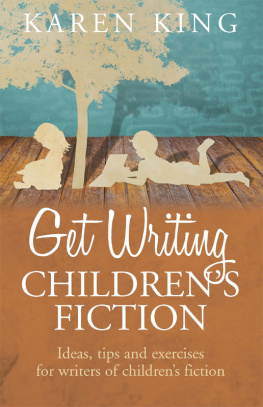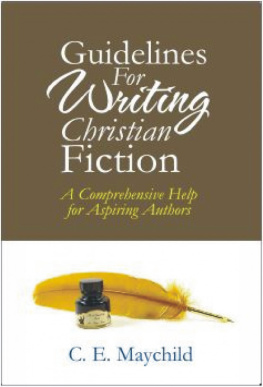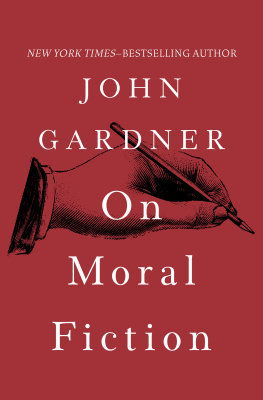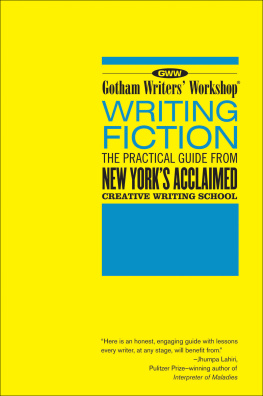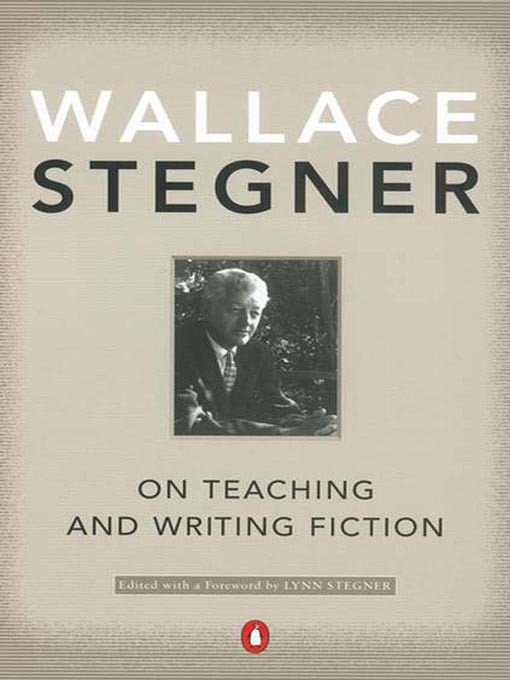Table of Contents
PENGUIN BOOKS
ON TEACHING AND WRITING FICTION
Wallace Stegner (19091993) was the author of, among other novels, Remembering Laughter (1937); The Big Rock Candy Mountain (1943); Joe Hill (1950); All the Little Live Things (1967, Commonwealth Club Gold Medal); A Shooting Star (1961); Angle of Repose (1971, Pulitzer Prize); The Spector Bird (1976, National Book Award in 1977); Recapitulation (1979); and Crossing to Safety (1987). His nonfiction includes Beyond the Hundredth Meridian ( 1954); Wolf Willow (1963); The Sound of Mountain Water (essays, 1969); The Uneasy Chair: A Biography of Bernard DeVoto (1974); and Where the Bluebird Sings to the Lemonade Springs: Living and Writing in the West (1992). Three of his short stories have won O. Henry Prizes, and in 1980 he received the Robert Kirsch Award from the Los Angeles Times for his lifetime literary achievements. His Collected Stories was published in 1990.
Lynn Stegner is the author of two novels, Undertow (1993) and Fata Morgana (1995), both nominated for the National Book Award, and a novella triptych, Pipers at the Gates of Dawn (2000), which won the Faulkner Society Gold Medal. She has been the recipient of a National Endowment for the Arts Writing Fellowship and a Fulbright Scholarship to Ireland. She lives with her husband, the writer Page Stegner, and her daughter, Allison, dividing her time between Vermont and California.
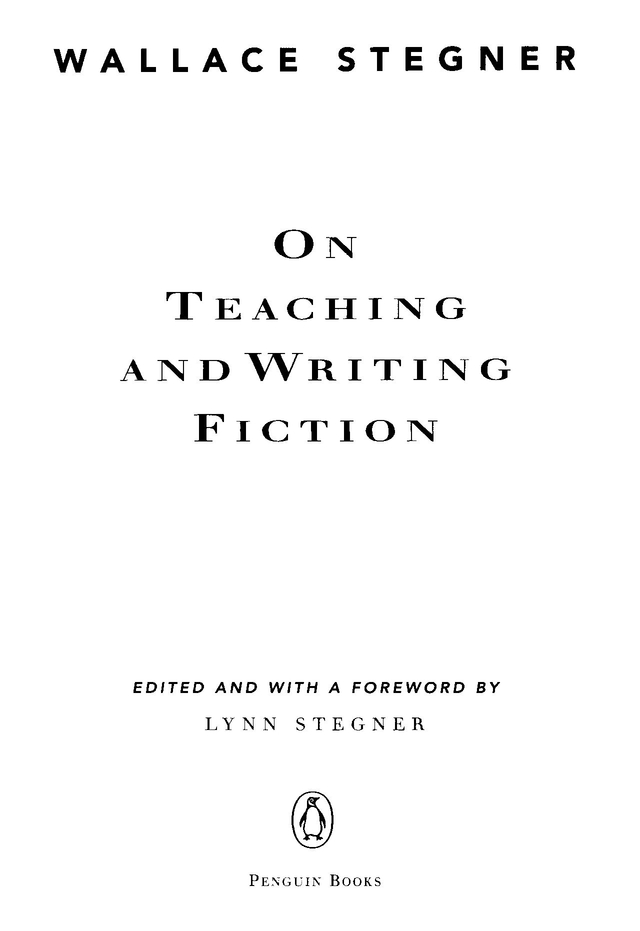
PENGUIN BOOKS
Published by the Penguin Group
Penguin Group (USA) Inc., 375 Hudson Street, New York, New York 10014, U.S.A.
Penguin Group (Canada), 90 Eglinton Avenue East, Suite 700, Toronto,
Ontario, Canada M4P 2Y3 (a division of Pearson Penguin Canada Inc.)
Penguin Books Ltd, 80 Strand, London WC2R ORL, England
Penguin Ireland, 25 St Stephens Green, Dublin 2, Ireland (a division of Penguin Books Ltd)
Penguin Group (Australia), 250 Camberwell Road, Camberwell,
Victoria 3124, Australia (a division of Pearson Australia Group Pty Ltd)
Penguin Books India Pvt Ltd, 11 Community Centre, Panchsheel Park, New Delhi -110 017, India
Penguin Group (NZ), cnr Airborne and Rosedale Roads,
Albany, Auckland 1310, New Zealand (a division of Pearson New Zealand Ltd)
Penguin Books (South Africa) (Pty) Ltd, 24 Sturdee Avenue,
Rosebank,Johannesburg 2196, South Africa
Penguin Books Ltd, Registered Offices: 80 Strand, London WC2R ORL, England
First published in Penguin Books 2002
Copyright Page Stegner, 2002
Selection and foreword copyright Lynn Stegner, 2002
All rights reserved
LIBRARY OF CONGRESS CATALOGING-IN-PUBLICATION DATA
Stegner, Wallace Earle, 1909
On teaching and writing fiction / Wallace Stegner ;
edited and with a foreword by Lynn Stegner
p. cm.
eISBN : 978-0-142-00147-9
1. FictionAuthorship. 2. FictionStudy and teaching.
I. Stegner, Lynn. II. Title.
PN3355 .S76 2002
808.3dc21 2002028993
http://us.penguingroup.com
ACKNOWLEDGMENTS
Fiction: A Lens on Life, To a Young Writer, and Good-bye to all Tt! from One Way to Spell Man by Wallace Stegner (Doubleday, 1982). Fiction: A Lens on Life first appeared in Saturday Review. By permission of the Estate of Wallace Stegner.
On the Teaching of Creative Writing: Responses to a Series of Questions edited by Edward Connery Lathem, Montgomery Endowment, Dartmouth College, 1988. Copyright 1988 by Wallace Stegner. By permission of the Estate of Wallace Stegner. This work is based upon and extends from tape-recorded discussions that Wallace Stegner engaged in with Professors Jay L. Parini and A. B. Paulson and with visiting author, Ishmael Reed, before a Dartmouth College audience during his period in residence at the College as a Montgomery Fellow in June and July of 1980.
Goin to Town from The Big Rock Candy Mountain by Wallace Stegner. Originally appeared in The Atlantic Monthly. Copyright 1938, 1940, 1942, 1943 by Wallace Stegner. Used by permission of Doubleday, a division of Random House, Inc.
All other materials are from manuscripts in the Wallace Stegner archives.
FOREWORD
LET US IMAGINE a student of today entering Stanfords Writing Program; Wallace Stegner is still alive and directing the program, and our studentsay, an eager fellow from Kansas hoping to maximize his educational opportunities (not to mention his parents investment)decides to conduct some pre-course background research on his prospective mentor. What if the guy is a postmodern fabulist by way of deconstructionism bent on squeezing the life from The Story? Or someone who spends his time writing obscure monographs on emergent models of fiction, comparative linguistic programming and the neoteric text, and other such ultra-refinements of academe? This would not do for our young man from Kansas who simply wants to write good fiction.
In the library computer cataloguing system he discovers screen after screen of Stegner publications, over thirty-five books, five dozen short stories, hundreds of articles, contributions, books edited, foreworded, introduced, critically examinedand our zealous pupil is sent pinballing his way from fiction to history to biography to conservation to sociology, even to religion. Wallace Stegner, he realizes, is the literary equivalent of one-stop shopping, and the education this Kansan might receive just from reading Wallace Stegner begins to resemble what used to be the aim of higher educationa Renaissance Man.
A fiction writer has to be a jack of all knowledges, Stegner says in one of his essays. He is a citizen of the culture. Despite significant journeys into other fields of inquiry, despite the quality and originality of his scholarship, particularly in the study of Western history and conservation, despite his many ancillary involvements, fiction remained Stegners first-born and favorite son. The uncovered or discovered truth would always be more compelling than the given facts, for reality, as he has said, waits to be civilized into fiction. Of the hundreds of thousands of pages Stegner produced during his lifetime, from first, to fifteenth, to final drafts (because he was, above all else, a believer in revision), fewer than two hundred pages concern the art of fiction, and even fewer address directly creative writing as a communicable craft.
Among artists this reticence is probably not uncommon. And there may be fairly obvious explanations, not the least of which is that working artists seldom take the time, or feel the inclination, or finally possess the ability to communicate how they do what they do. Imagine Beethoven, completely deaf by his mid-fifties, trying to explain how he first heard the Missa Solemnis that he later composed. For some, part of the creative mystery lies deep within the moat of silence surrounding the work, the very incapacity to articulate its dimensions and traits providing protection; for others, talking about it poses very real danger, gusts of wind in card houses. Minimally, it seems an insult, like a heathens lumbering footsteps through a place of private worship. For writers as a subgroup, reluctance may be intensified by the deeply personal and experiential synapse between their lives and the subjects of their books, so that any examination of the process conjures visions of stripping down in the cold light of the schoolyard.


